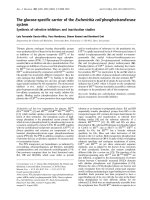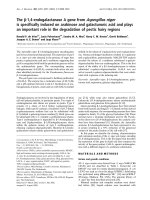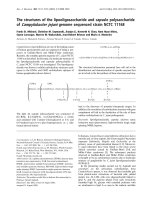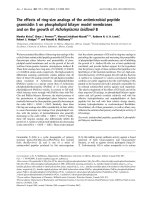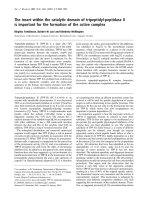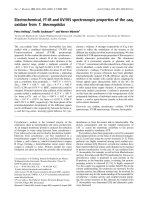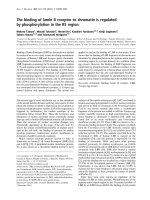Báo cáo Y học: The group I-like ribozyme DiGIR1 mediates alternative processing of pre-rRNA transcripts in Didymium iridis pptx
Bạn đang xem bản rút gọn của tài liệu. Xem và tải ngay bản đầy đủ của tài liệu tại đây (252.52 KB, 9 trang )
The group I-like ribozyme DiGIR1 mediates alternative processing
of pre-rRNA transcripts in
Didymium iridis
Anna Vader
1,2
, Steinar Johansen
2
and Henrik Nielsen
1
1
Department of Medical Biochemistry and Genetics, The Panum Institute, Copenhagen, Denmark;
2
Department of Molecular
Biotechnology, Institute of Medical Biology, University of Tromsø, Norway
During starvation induced encystment, cells of the myxo-
mycete Didymium iridis accumulate a 7.5-kb RNA that is the
result of alternative processing of pre-rRNA. The 5¢ end
corresponds to an internal processing site cleaved by the
group I-like ribozyme DiGIR1, located within the twin-
ribozyme intron Dir.S956-1. The RNA retains the majority
of Dir.S956-1 including the homing endonuclease gene and a
small spliceosomal intron, the internal transcribed spacers
ITS1 and ITS2, and the large subunit rRNA lacking its two
group I introns. The formation of this RNA implies clea-
vage by DiGIR1 in a new RNA context, and presents a new
example of the cost to the host of intron load. This is because
the formation of the 7.5-kb RNA is incompatible with the
formation of functional ribosomal RNA from the same
transcript. In the formation of the 7.5-kb RNA, DiGIR1
catalysed cleavage takes place without prior splicing per-
formed by DiGIR2. This contrasts with the processing order
leading to mature rRNA and I-DirI mRNA in growing cells,
suggesting an interplay between the two ribozymes of a twin-
ribozyme intron.
Keywords: Didymium iridis; group I intron; ribozyme; pre-
rRNA processing.
Group I introns contain a conserved set of sequences and
structural elements that are involved in the removal of the
intron by splicing. They constitute one class out of fewer
than 10 classes of naturally occurring ribozymes [1].
Group I introns vary considerably in complexity. Most
introns contain only the sequence information required for
splicing, whereas others contain large extensions of the
peripheral domains. Some of the larger group I introns
contain an open reading frame, usually represented by a
homing endonuclease gene (HEG). HEGs are found in
different configurations, e.g. fused in frame with the
upstream exon or as an independent expression unit [2].
The most complex group I introns are the twin-ribozyme
introns that in addition contain a group I-like cleavage
ribozyme (GIR1) involved in the expression of the intron
HEG [3].
The complex structure of the twin-ribozyme introns
suggests a complex biology. This has been demonstrated in
the case of the Dir.S956-1 (former DiSSU1; the recently
introduced nomenclature for group I introns [4] is used
throughout this paper) intron found in the small subunit
ribosomal RNA (SSU rRNA) gene in the myxomycete
Didymium iridis (Fig. 1). One of the ribozymes (DiGIR2)
catalyses intron excision and exon ligation (Fig. 1, left
panel). In addition, this ribozyme displays a pronounced 3¢
splice site hydrolysis activity, which induces the formation
of full-length intron RNA circles using a processing
pathway that is distinctly different from splicing ([5];
unpublished data]. The other ribozyme (DiGIR1), which
along with the I-DirI HEG is inserted in DiGIR2, carries
out hydrolysis at two internal processing sites (IPS1 and
IPS2) located at its 3¢ end [5,6]. In vivo, this cleavage results
in the formation of the 5¢ end of the I-DirImRNAandis
followed by cleavage at an in vivo specific internal processing
site (IPS3) downstream of the HEG and by polyadenylation
(summarized in Fig. 1, left panel). Finally, a 51-nucleotide
spliceosomal intron (I51) within the HEG RNA is removed
before the resulting I-DirI mRNA is transported to the
cytoplasm where it associates with the polysomes [7].
Homing activity of the I-DirI protein has been demonstra-
ted by Dir.S956-1 intron mobility studies involving genetic
crosses between intron-containing and intron-lacking
Didymium isolates [8].
During our work on the in vivo expression of Dir.S956-1,
we noted the presence of an I-DirI HEG-containing RNA
species that migrated similarly to the 7.46-kb ladder band on
a denaturing agarose gel, but did not hybridize to an SSU
probe. This observation, as well as reverse transcription/
PCR analyses which showed that Dir.S956-1 produces full-
length intron circles in vitro [9] and in vivo [10], led us to
believe that this unknown RNA represented a circular
species that was retarded in the gel during electrophoresis.
We have subsequently observed that the signal intensity of
the 7.5-kb band varies greatly according to the state of the
D. iridis culture when the RNA was isolated. To address the
question of its formation and possible function in cellular
I-DirI expression, we here investigate its identity and
distribution. We demonstrate that the RNA is a 7.5-kb
Correspondence to H. Nielsen, Department of Biochemistry and
Genetics, Laboratory B, The Panum Institute, Blegdamsvej 3,
DK-2200 N, Denmark. Fax: +45 35 32 77 32, Tel.: +45 35 32 77 63,
E-mail:
Abbreviations:DiGIR,Didymium group I ribozyme; SSU, small
subunit; LSU, large subunit; ETS, external transcribed spacer; ITS,
internal transcribed spacer; HEG, homing endonuclease gene;
IPS, internal processing site.
(Received 24 July 2002, revised 24 September 2002,
accepted 30 September 2002)
Eur. J. Biochem. 269, 5804–5812 (2002) Ó FEBS 2002 doi:10.1046/j.1432-1033.2002.03283.x
linear species generated by an unusual pre-rRNA processing
event mediated by DiGIR1, and that it accumulates during
starvation-induced encystment in D. iridis.
EXPERIMENTAL PROCEDURES
Cell cultivation, RNA isolation and Northern blotting
analysis
The intron-containing D. iridis strain Lat3-5, derived from
the Pan2-44 isolate, has been described previously [8]. The
cells were cultured at 26 °C in liquid media (DS/2;
1mgÆmL
)1
D
-glucose, 0.5 mgÆmL
)1
yeast extract,
0.1 mgÆmL
)1
MgSO
4
,1mgÆmL
)1
KH
2
PO
4
,1.5mgÆmL
)1
K
2
HPO
4
) containing Escherichia coli cells. Cells and cysts
were counted in a Tu
¨
rk chamber or electronically in a
Coulter Multisizer (Coulter Electronics Ltd). Cysts were
scored by their ability to resist lysis in 0.5% Nonidet P-40
[11]. Cysts were stained by the addition of 1 vol. 0.25%
Trypan Blue in standard NaCl/P
i
.
For RNA extraction, a total of 10
7
Didymium cells
were harvested by centrifugation at 400 g for 5 min The
pellet was dissolved in 1 mL Trizol Reagent (Gibco-BRL)
and RNA extracted according to the manufacturer’s
instructions. Aliqouts of RNA were denatured for 15 min
at 65 °C in loading buffer (1 · Mops, 17.8% formalde-
hyde, 50% formamide, 12 ngÆlL
)1
ethidium bromide) and
fractionated on a 5.3% formaldehyde/1% agarose gel in
5.3% formaldehyde/1 · Mops (40 m
M
Mops, 10 m
M
NaAc, 2 m
M
EDTA, 0.04% HAc). The RNA was then
transferred to a nylon membrane by Northern blotting
using capillary action. Hybridization was carried out
either in Rapid Hyb solution (AP Biotech) or in Ultrahyb
solution (Ambion) according to the manufacturer’s
instructions.
The external transcribed spacer (ETS), GIR1, HEG,
GIR2, internal transcribed spacer (ITS)1, ITS2 and large
subunit (LSU)1 probes were amplified from Lat3-5 genomic
DNA [8] by PCR using the oligo pairs OP448/OP449,
OP20/C78, OP1/OP2, OP11/OP180, SSU6/SSU7, C231/
C232 and OP65/OP169, respectively. The sequences of the
oligonucleotides are: OP1, 5¢-CACTTCTAGAACCA
TGGTGAAAGGAACG-3¢;OP2,5¢-TGTCTGGATCCT
CATCTG-3¢;OP4,5¢-TGTTGAAGTGCACAGATT-3¢;
OP11, 5¢-GACTAGTTGACTTCTCACAGA-3¢; OP20,
5¢-TTGAACACTTAATTGGGT-3¢;OP65,5¢-GGAG
Fig. 1. Homing endonuclease gene expression and life cycle of D. iridis. Proposed processing pathways in the formation of RNA species encoded by
the Dir.S956-1 homing endonuclease gene (HEG). In vegetatively growing D. iridis, the Dir.S956-1 intron is spliced out from pre-rRNA and further
processed into an I-DirI endonuclease mRNA (left panel; see [7] for details). Starvation/encystment results in an alternative processing pathway of
the intron (right panel), induced by DiGIR1 ribozyme cleavage at an internal intron processing site. Subsequently, a 7.5-kb linear RNA is formed
after the excision of the LSU rRNA introns Dir.L1949 and Dir.L2449. The accumulated 7.5-kb RNA contains all of the Dir.S956-1 sequences
except those encoding the cleavage ribozyme DiGIR1. A possible functional role of the 7.5-kb RNA is as an alternative precursor for the
endonuclease mRNA during excystment. Here, the HEG RNA might be separated from the remaining 7.5-kb RNA sequences by cleavage at the
host induced IPS3 or the ribozyme induced 3¢ splice site. (A) 1.46 kb RNA (the full length intron after splicing). (B) 1.23 kb RNA (resulting from
GIR1 cleavage). (C) 0.90 kb RNA (resulting from cleavage at IPS3). (D, E) Nuclear and cytoplasmic form of the 0.85 kb RNA also referred to as
the I-DirI mRNA. (Inset) Life cycle of the myxomycete D. iridis. Haploid amoebae or swarm cells can transform into dormant cysts under
unfavourable environmental conditions. This process is reversible. Alternatively, two compatible amoebae or swarm cells can act as gametes and
fuse to produce a diploid zygote. Growth of the zygote is accompanied by a series of nuclear divisions, leading to the formation of a multinucleated
plasmodium. Eventually, the plasmodium transforms into fruiting bodies, which release haploid spores. Germination of the spores completes the
life cycle, in that vegetative amoebae or swarm cells are formed again.
Ó FEBS 2002 Ribozyme mediated processing of pre-rRNA (Eur. J. Biochem. 269) 5805
GTTCAGAGACTATA-3¢;OP169,5¢-ACCTAAGGC
GGACGTTACTG-3¢;OP180,5¢-GCCTCCCTTGGGA
TAT-3¢; OP448, 5¢-AACCGAACAATGAGACTGAA-3¢;
OP449, 5¢-CTCGTATTCGAAGGCATGCA-3¢;C78,
5¢-TGCTTCCTTTCGGAACGA-3¢; C231, 5¢-ATTCCGA
TATCGTGCTCTA-3¢; C232, 5¢-AAGAGGTTGGCCAA
GGAA-3¢; SSU6, 5¢-CGAATTCAGGGGCAACATCGG
TTC-3¢;SSU7,5¢-CGAATTCACCGAGGTTACAAG
GCA. The ETS, GIR1, HEG, GIR2 and LSU1 PCR
products were purified on S-300 spin-columns (Pharmacia)
prior to labelling by random priming using the Mega Prime
kit (Amersham) and [a-
32
P]dCTP (3000 CiÆmmol
)1
;
Amersham). The ITS1 and ITS2 PCR products were
cloned using the Topo TA cloning kit (version J, Invitrogen)
according to the manufacturer’s instruction. Plasmids
harbouring the ITS1 insert in the correct orientation were
linearized by HindIII digestion, while the ITS2 insert was
further subcloned into the XbaI/HindIII site of the pBlue-
script+ vector (Stratagene) to obtain the correct orienta-
tion. The resulting pBluescript plasmid was linearized with
XbaI.
Riboprobes were transcribed from 500 ng linearized
template DNA using 500 l
M
each of rATP, rCTP and
rGTP, 25 l
M
rUTP, 0.5 l
M
[a-
32
P]UTP (3000 CiÆmmol
)1
;
Amersham), 10 m
M
dithiothreitol and 50 U T7 RNA
polymerase (Stratagene) in 20 lLof1· the supplied buffer
at 37 °Cfor1h.
RNaseH analysis
A mix consisting of 6 lg RNA and 50 pmol oligo was
heated in 1 · RNaseH buffer (GibcoBRL) at 80 °Cfor
1min.At45°C, 20 U RNasin (Pharmacia) was added, and
the sample incubated for 10 min. After transfer to ice, 0.5 U
RNaseH (GibcoBRL) was added to produce a total volume
of 10 lL. The sample was then incubated at 30 °Cfor
5 min, prior to analysis by Northern blotting (see above).
Primer extension
For primer extension, gel-purified OP4 was labelled with
[a-
32
P]ATP (3000 CiÆmmol
)1
, Amersham) using T4 poly-
nucleotide kinase (Gibco-BRL). RNA was added to 2 pmol
labelled oligo in 1 · RT buffer (50 m
M
Tris/HCl at pH 8,
60 m
M
KCl, 10 m
M
MgCl
2
,1m
M
dithiothreitol) in a total
volume of 5 lL, denatured at 80 °Cfor2minand
incubated at 45 °C for 10 min. Subsequently 4 lLRNA/
oligo mixture was added to a tube containing 1 U AMV
reverse transcriptase (RT; Pharmacia), 1 U RNasin
(Promega), 0.2 m
M
dATP, dCTP and dTTP and 0.4 m
M
dGTP (Pharmacia) in 1 · RT buffer. The reaction was
incubated1 hat40°C before being stopped by the addition
of 5 lL formamide loading buffer. The primer extension
product was denatured by heating at 100 °Cfor1min
before separation on an 8
M
urea/8% polyacrylamide gel.
Cell fractionation and sucrose gradients
DS/2 (see above) was added to 2 · 10
7
Lat3-5 cells to a total
volume of 2 · 14 mL and centrifuged in two tubes at 300 g
for 5 min The pellet from one tube was dissolved in 1 mL
Trizol (see above) for extraction of total RNA. The cells in
the other tube were resuspended in 250 lL ice-cold lysis
buffer (20 m
M
Tris/HCl pH 8.0, 1.5 m
M
MgCl
2
,140m
M
KCl, 1.5 m
M
dithiothreitol, 1 m
M
CaCl
2
,0.1m
M
EDTA,
0.16 m
M
cycloheximide, 0.5% Nonidet P-40, 500 UÆmL
)1
RNasin), incubated for 5 min in ice/water to allow lysis of
the cells and centrifuged at 10 000 g,4°C for 10 min. The
pelleted nuclei were dissolved in Trizol (nuclear RNA), and
the supernatant was extracted with phenol/chloroform and
precipitated by EtOH (cytosolic RNA).
For sucrose gradients, 250 lg whole cell RNA was
heated to 70 °C for 5 min, cooled on ice and centrifuged at
13 000 g,4°C for 5 min The supernatant was loaded onto
a linear 15–40% sucrose gradient in 10 m
M
Tris/HCl at
pH 7.5, 100 m
M
LiCl, 10 m
M
EDTA and 0.2% SDS and
centrifuged for 20 h at 4 °C and 25 000 r.p.m. in a Beckman
SW27.1 rotor. Fractions of approximately 1 mL were
collected and RNA was isolated by phenol/chloroform
extraction.
RESULTS
A 7.5-kb I-DirI HEG RNA signal is enriched upon
starvation of Didymium cells
The life-cycle of a typical myxomycete can be roughly
divided into a diploid macroscopic stage consisting of a
plasmodium and the fruiting bodies that develop from it,
and a haploid microscopic stage (see Fig. 1B). Haploid
myxomycete cells are uninucleate and exist in two intercon-
vertible active states; nonpolarized amoebae and polarized
flagellated swarm cells. The particular form in which a given
cell exists depends largely upon the amount of water in the
environment, with swarm cells tending to dominate under
aqueous conditions. In nature, myxamoebae or swarm cells
feed by phagocytosis of bacteria. Under conditions unfa-
vourable for continued growth, such as starvation, the
vegetative cells will develop into dormant cysts. Cysts can
remain viable for long periods of time, and have been
suggested to be very important for the survival of
myxomycetes in some habitats.
To examine whether the cellular amount of the 7.5-kb
I-DirI HEG RNA correlates with food availability, intron-
harbouring Lat3-5 amoebae were grown in monoxenic
culture using E. coli as a food source (Fig. 2A). As the
cells grow and multiply, food is depleted (time points 1–5)
and the myxamoebae gradually transform into very active
swarm cells (points 5–6). Eventually, activity ceases and the
starving cells develop into dormant cysts (point 7). As
encystment is defined by the formation of a cell wall, we
have chosen to score cysts by their ability to resist lysis in
0.5% Nonidet P40 [11]. However, it is important to keep in
mind that cyst formation is most likely committed
biochemically long before this time. Examination of whole
cell RNA from a time course of a Didymium culture shows
that the 7.5-kb RNA is hardly detectable at the first time
points when food is plentiful, but becomes abundant when
the cells are starved and the culture reaches the stationary
phase (Fig. 2B). At the last time points the 7.5-kb RNA is
the predominant HEG RNA in the cells. While the
amounts of some of the other HEG RNA species also
vary, none exhibits the same pattern. It is interesting to
note that another prominent signal corresponding to a 3.9-
kb RNA, which comigrates with the LSU rRNA, decrea-
ses as the 7.5 kb signal increases. The 3.9 kb RNA appears
5806 A. Vader et al. (Eur. J. Biochem. 269) Ó FEBS 2002
to be a nuclear species [7], and a similar RNA has been
observed when whole cell RNA from the Didymium CR8
isolate was probed with the Dir.S956-2 group I intron [10].
The fact that the Dir.S956-1 and Dir.S956-2 group I
introns are unrelated [10], suggests that the formation of
the 3.9 kb RNA is independent of the intron, and results
from a more general alternative pathway of Didymium pre-
rRNA processing.
The 7.5-kb signal is a linear RNA made by alternative
processing of the pre-rRNA
To confirm that the 7.5-kb signal indeed represented a
circular form of the Dir.S956-1 intron RNA, the following
experiments were carried out. First, RNA from the time
course experiment shown in Fig. 2, was analysed on a
denaturing 4% polyacrylamide gel in diluted electro-
phoresis buffer (0.4 · TBE). Under these conditions we
know ) from repeated experiments using in vitro tran-
scribed and processed RNA ) that circles are retarded and
thus efficiently separated from the corresponding linear
form of the intron RNA. Northern blotting analysis showed
that an RNA with the same migration as a Dir.S956-1 circle
is indeed present in Didymium cells, but that this RNA is
enriched at the start of the time course rather than during
starvation (data not shown). Second, the circular and linear
forms of Dir.S956-1 RNA from an in vitro splicing reaction
were separated on a denaturing polyacrylamide gel, cut out
and recovered after elution. The RNA species were analysed
on a denaturing agarose gel. The results showed that the
Dir.S956-1 circle is only slightly retarded on an agarose
gel (data not shown). Thus, contrary to our previous
Fig. 2. Analysis of RNA from D. iridis Lat3-5 cells harvested from a time course growth experiemt. (A) Time course of culture growth, showing
starvationandsubsequentencystmentofvegetativeD. iridis Lat 3-5 cells. The time points when total number of Didymium cells (d), number of
encysted cells (s)oramountofE. coli food (j) was measured are indicated. The numbered arrows denote the time points when RNA samples were
obtained. (B) Northern blot of Lat3-5 whole cell RNA. Didymium cells (5 · 10
6
) were harvested at the time points indicated in (A). After extraction,
the RNA was separated on a 1% denaturing agarose gel and analysed by Northern blotting analysis using the HEG probe described in Fig. 3A. An
overview of the observed intron RNA species is shown to the right. Exon, open reading frame and intron sequences are indicated in black, grey and
white, respectively. The position of the 5¢ and 3¢ splice sites (SS) as well as internal processing sites (IPS) are indicated. The 1.46-kb RNA is the full-
length excised Dir.S956-1 intron, while 1.23-kb RNA and 0.85-kb RNA represent processed forms of the intron RNA [7]. The 7.5-kb signal under
investigation is denoted**, while the identity of the signal marked * is discussed in the text. The size indications are derived from the 0.24–9.5 kb
ladder (GibcoBRL) visualized by ethidium bromide staining.
Ó FEBS 2002 Ribozyme mediated processing of pre-rRNA (Eur. J. Biochem. 269) 5807
suggestion, the 7.5-kb signal does not correspond to the full
length circular intron RNA.
Next, we hypothesized that the 7.5-kb RNA is formed by
an alternative processing of the pre-rRNA in which the SSU
rRNA sequence upstream of Dir.S956-1 is removed. This
hypothesis would similarly be consistent with the previously
published observation of lack of hybridization of an
upstream SSU probe to the 7.5-kb RNA [7]. Considering
the low abundance of this RNA compared with ribosomal
RNAspecies,andthefactthatitcoexistswithRNAs
containing the same structural elements, we decided to
deduce its structure by analysis of preparations of whole cell
RNA rather than to isolate it. Whole cell RNA was isolated
from Didymium cellsharvestedearlyandlateinatime
course (corresponding to time points 1 and 6 in Fig. 2).
These RNAs were analysed by Northern blotting and
RNaseH cleavage. In the Northern blotting analysis,
parallel filters were hybridized with a panel of probes
complementary to different parts of the Didymium pre-
rRNA including ETS, HEG, ITS1 and ITS2 (Fig. 3A). A
signal of 9.5 kb was detected only by the non-Dir.S956-1
probes (i.e. ETS, ITS1 and ITS2; Fig. 3B), suggesting that it
represents the pre-rRNA subsequent to Dir.S956-1 excision.
The observation of the 9.5 kb RNA is in agreement with
splicing being one of the earliest events in pre-rRNA
processing, as previously shown for the Tth.L1925 intron in
Tetrahymena thermophila [12]. Although information on the
precise location of the 5¢ and 3¢ ends of Didymium pre-
rRNA is not available, the size of 9.5 kb for this RNA is
in reasonable agreement with the expected size based
on reported ribosomal DNA sequences from different
Didymium isolates.
Fig. 3. Characterization of the 7.5-kb RNA signal. (A) Schematic presentation of the D. iridis (Lat3-5 strain) rDNA. The upper panel shows the
SSU and LSU rRNA genes, as well as the position of the Dir.S956-1, Dir.L1949 and Dir.L2449 group I introns [9,18]. Exon and intron sequences
are denoted in black and white, respectively. The localization of the probes applied for Northern blotting analyses is indicated with thick black lines.
The lower panel is an enlarged segment of the upper panel, and shows the positions of the oligonucleotides used in RNaseH analysis. (B) Northern
blotting analysis of whole cell RNA. Parallel filters containing RNA from Didymium cells harvested at an early (E) and late (L) time point
(corresponding to positions 1 and 6 in Fig. 2A) were hybridized with the probes indicated. The size indications are derived from the 0.24- to 9.5-kb
ladder (GibcoBRL) visualized by ethidium bromide staining. (C) RNaseH analysis of the 7.5-kb RNA signal. Whole cell RNA from a late time
point (corresponding to point 6 in Fig. 2A) was fractionated on a 15–30% sucrose gradient (see Fig. 5). Fractions enriched in the 7.5-kb RNA, as
determined by Northern blotting analysis, were pooled and the extracted RNA subjected to RNaseH analysis with the oligonucleotides indicated.
The resulting RNA was analysed by Northern blotting using the HEG probe shown in (A). The size indications are derived from the High Range
RNA ladder (Fermentas) visualized by ethidium bromide staining.
5808 A. Vader et al. (Eur. J. Biochem. 269) Ó FEBS 2002
The RNA species that are involved in expression of the
HEG, and particularly those that are involved in the
formation of the 7.5-kb RNA, are considerably less
abundant than most of the ribosomal RNA precursors.
For this reason, detection of HEG RNAs with non-HEG
probes was technically difficult. Nevertheless, a 7.5-kb signal
specific for late RNA was identified by the ITS1 and ITS2
probes, but was absent when a 5¢ ETS probe was used
(Fig. 3B). The 7.5-kb RNA was furthermore detected by
exonic LSU probes but was not detected by probes targeted
towards the LSU introns (data not shown). The absense of
the LSU introns in the 7.5-kb RNA implies a different
splicing order during the formation of this RNA compared
with normal processing of the pre-rRNA in which the
Dir.S956-1 sequences are removed prior to the LSU introns
(see above). The expected size of an RNA composed of the
elements suggested by the Northern blotting experiment is
7.6 kb which is in good agreement with the observed size
of 7.5 kb.
In the RNaseH analysis, the parallel RNA samples
were hybridized to oligonucleotides complementary to
different parts of the Didymium pre-rRNA (see Fig. 3A).
RNaseH, which will degrade the RNA strand of the
resulting RNA : DNA heteroduplexes, was then added.
The resulting RNA fragments were visualized by
Northern blotting analysis using a HEG probe. The
experiment showed that oligonucleotides complementary
to ITS-1, ITS-2, LSU as well as the SSU-sequence
downstream of Dir.S956-1 will induce RNaseH-catalysed
cleavage of the 7.5-kb RNA and result in cleavage
products of the expected size (Fig. 3C). Oligonucleotides
complementary to SSU sequences upstream of Dir.S956-1,
on the other hand, had no effect (data not shown),
showing that these sequences are not part of the 7.5-kb
RNA. Taken together, the data from Northern blotting
and RNaseH analyses are consistent with the hypothesis
that the 7.5-kb RNA signal is a linear species produced by
alternative processing of the pre-rRNA.
Only parts of the Dir.S956-1 intron are included in the
7.5-kb RNA
To determine if all of the Dir.S956-1 intron is included in the
7.5-kb RNA, filters containing whole cell RNA from early
and late points in a time course (see above) were hybridized
with probes complementary to GIR1, HEG and GIR2
(Fig. 4A). Surprisingly, the Northern blotting results dem-
onstrated that GIR1 is absent from the 7.5-kb RNA
(Fig. 4B). RNaseH analyses substantiated this conclusion in
that oligonucleotides complementary to GIR1 did not
cleave the 7.5-kb RNA, whereas oligonucleotides that
hybridize to different parts of the HEG or GIR2 led to
cleavage (data not shown). The sizes of the upstream
cleavage products, detected by their hybridization to a HEG
probe in Northern blotting analysis, suggested that the 5¢
end of the 7.5-kb RNA was located at or near the internal
processing sites IPS1/2.
RNaseH analysis was also used to examine whether the
51-nucleotide spliceosomal intron within the HEG is present
in the 7.5-kb RNA. This intron is removed during
maturation of the I-DirImRNAfromtheexcised
Dir.S956-1 RNA [7]. Cleavage with an oligonucleotide
complementary to the spliceosomal intron sequences
showed that these are retained in the 7.5-kb RNA (data
not shown).
The DiGIR1 ribozyme catalyses 5¢ end formation of the
linear 7.5-kb RNA
To map precisely the 5¢ end of the 7.5-kb RNA, it was
necessary to separate it from other Dir.S956-1-containing
RNAs in the cell. Whole cell RNA from a late time point
was fractionated by ultracentrifugation through a 15–40%
sucrose gradient (Fig. 5A). Screening of the collected
fractions by Northern blotting analysis, showed that the
HEG-containing RNAs could successfully be separated
according to size (Fig. 5B). Primer extension with an oligo
complementary to the 5¢ end of the HEG produced only
one signal which corresponded to IPS2 (Fig. 5C). The
intensity of the signal through the fractions suggested that
two populations of HEG RNAs with this end exist in the
Fig. 4. Characterization of the intronic part of the linear 7.5-kb RNA.
(A) Schematic presentation of the Dir.S956-1 intron, showing the
position of the 5¢ and 3¢ splice sites (SS) as well as the internal pro-
cessing sites (IPS). The exon, open reading frame and intron sequences
are shown in black, grey and white, respectively. The localization of the
probes used for Northern blotting analysis are indicated with thick
black lines. (B) Northern blotting analysis of whole cell RNA. Parallel
filters containing RNA from an early (E) and a late (L) time point
(corresponding to positions 1 and 6 in Fig. 2A) were hybridized with
the indicated GIR1, HEG and GIR2 probes. The G319 RNA marker
(Promega) was used as a size marker.
Ó FEBS 2002 Ribozyme mediated processing of pre-rRNA (Eur. J. Biochem. 269) 5809
cells. As expected, IPS2-terminated RNAs were found in
the low molecular mass fractions where the processed
forms of the excised Dir.S956-1 (1.23-kb RNA and 0.85-
kb RNA; see Fig. 2) are located. Another IPS2-termin-
ated HEG RNA exists in the high molecular fractions
where the 7.5-kb RNA is the predominant HEG RNA.
This implies that the 5¢ end of the 7.5-kb RNA
corresponds to IPS2. While DiGIR1 cleaves at two
processing sites (IPS1 and IPS2) in an obligate sequential
order in vitro [6], only IPS2-cleaved RNA has been
detected in vivo [7]. We infer that 5¢ end formation of the
7.5-kb RNA is a result of DiGIR1 catalysis. The critical
involvement of DiGIR1 in the formation of the 5¢ end of
the RNA could be tested by the introduction of mutations
in the catalytic site of the ribozyme [3]. Unfortunately, a
transformation protocol for Didymium is currently not
available.
The 7.5-kb RNA is located in the nucleus
Previous studies have shown that the different I-DirIHEG
RNAs differ in their intracellular distribution. While the
fully processed 0.85-kb RNA is located almost exclusively in
the cytosol, all other examined HEG RNAs (3.9 kb,
1.46 kb, and 1.23 kb RNA, respectively; see Fig. 2) are
nuclear [7]. In order to examine the subcellular location of
the 7.5-kb RNA, Didymium Lat3-5 cells from a late time
point (corresponding to 6 in Fig. 2A) were lysed and
fractionated by centrifugation and RNA isolated from the
nuclear and cytosolic fractions. Although we had some
difficulties recovering large RNAs after the fractionation
procedure, probably due to high nuclease activity in the
encysting cells, the resulting Northern blot indicated a
nuclear localization for the 7.5-kb RNA (Fig. 6). As
expected, the 0.85-kb RNA was the only HEG RNA
species to be found in the cytosol. As such, it provided
an internal control for the success of the fractionation
procedure.
DISCUSSION
We have previously noted the presence of an I-DirIHEG
RNA signal corresponding to 7.5 kb when D. iridis Lat3-5
RNA was analysed by Northern blotting [7]. We show here
that this RNA is a linear species, produced by alternative
processing of the pre-rRNA. The 5¢ end of the RNA
corresponds to an internal processing site in Dir.S956-1
(IPS2), implying that it is formed through cleavage by the
DiGIR1 ribozyme. The 3¢ end has not been mapped but is
assumed to correspond approximately to the 3¢ end of the
pre-rRNA. Apart from two group I introns in the LSU
rRNA (Dir.L1949 and Dir.L2449), the 7.5-kb RNA
Fig. 6. Intracellular localization of the 7.5-kb RNA. Total(T),nuclear
(N) and cytosolic (C) RNA from 5 · 10
5
Lat3-5 cells was run on a 1%
denaturing agarose gel and analysed by hybridization using the HEG
probe described in Fig. 3A. The identity of the observed signals is
indicated on the right. The size indications are derived from the High
Range RNA ladder (Fermentas).
Fig. 5. Mapping of the 5¢ end of the linear 7.5-kb RNA. Whole cell
RNA (250 lg) from a late time point (corresponding to position 6 in
Fig. 2A) was fractionated on a 15–40% sucrose gradient. In addition
to the pelleted material that had run through the gradient (P), 22
fractions were collected (1–22). (A) Denaturing agarose gel of fract-
ionated RNA. RNA was recovered from the collected fractions and
analysed on a 1% agarose gel stained with ethidium bromide. The
positions of the SSU and LSU rRNAs are indicated. The 0.24- to 9.5-
kb ladder (GibcoBRL) was used as a size marker (L). (B) Northern
blotting analysis of fractionated RNA. The gel shown in (A) was
analysed by hybridization using the HEG probe indicated in Fig. 4A.
The positions of the 7.5-kb RNA and the processed forms of the intron
(1.46-kb, 1.23-kb, and 0.85-kb RNA, respectively) are shown. The size
indications are derived from the ladder shown in (A). (C) Primer
extension analysis of fractionated RNA. RNA recovered from the
collected fractions was analysed using OP4 (an 18-mer complementary
to a sequence 35–52 nucleotides downstream of IPS2) as a primer. OP4
wasalsousedtomakeaDNAsequencingladderwhichwasusedto
determine the exact position of the primer extension stop at IPS2 as
indicated.
5810 A. Vader et al. (Eur. J. Biochem. 269) Ó FEBS 2002
contains all sequence elements downstream of IPS2 (see
Fig. 1, right panel). These include the LSU rRNA exons,
the internal transcribed spacers (ITS1 and ITS2) and the
part of the SSU rRNA that is located downstream of
Dir.S956-1. All intron sequences downstream of IPS2,
including the spliceosomal intron within the I-DirIprotein
coding region, are also present. The RNA is localized in the
nucleus, and accumulates when Didymium cells are starved.
In cells about to form dormant cysts, the 7.5-kb RNA is the
predominant I-DirIHEGRNA.Whenviewedasa
nonribosomal RNA, it is relatively abundant and remark-
ably stable considering the turn-over of other RNAs,
including ribosomal RNAs, that take place during
encystment.
Theexistenceofthe7.5-kbI-DirIHEGRNAis
surprising, as the molecule contains several intrinsic
activities and signals that would be expected to result in
its disappearance. Firstly, even though the cleavage by
DiGIR1 at IPS2 removes the 5¢ splice site site of
Dir.S956-1, the catalytic core of the DiGIR2 splicing
ribozyme remains intact. DiGIR2 RNAs with even larger
truncations in the 5¢ endhavepreviouslybeenshownto
perform efficient hydrolysis at the 3¢ splice site of
Dir.S956-1 [5]. Secondly, an internal processing site
(IPS3) is located downstream of the HEG region. The
site is cleaved during maturation of the mRNA from the
excised intron [7]. Thirdly, the 7.5-kb RNA contains a
polyadenylation signal, which in mRNA formation indu-
ces cleavage and polyadenylation of the I-DirImRNA.
Finally, a spliceosomal intron (I51) harboured by the
I-DirI HEG is removed in the mature I-DirI mRNA [7].
All of the activities mentioned above would be expected
to act against the preservation of the 7.5-kb RNA.
The composition of the 7.5-kb RNA suggests how it is
formed and no new activities need to be postulated to
account for its structure. Instead, its accumulation can be
explained by an alteration of the relative rates of known
processing activities. All of the experiments carried out in
the present study aim at analysing the steady-state level of
the RNAs involved. It is frequently observed that the
processing of pre-rRNA and pre-mRNA slows down
when cells are starved. In the ciliate Tetrahymena pyrifor-
mis, the pre-rRNA processing rate has been reported to be
decreased 36-fold during starvation [13] and a similar
12-fold decrease has been observed in T. thermophila [14].
As a result, precursors and processing intermediates
tend to show increased steady-state levels under such
conditions. In the present case, this could explain the
inclusion of ITS1 and ITS2 in the 7.5-kb RNA, as well as
the presence of the spliceosomal intron and the failure to
use the polyadenylation signals. The observed nuclear
localization of the 7.5-kb RNA is expected as the RNA
retains several putative nuclear retention signals, e.g. a
spliceosomal intron.
The accumulation of the 7.5-kb RNA during starva-
tion does not necessarily imply that this RNA is specific
for starved cells. It is possible that the 7.5-kb RNA is a
default intermediate in the formation of the I-DirI
mRNA that is rapidly turned over during normal
exponential growth and thus not detected by the methods
applied in the present study. This would leave the excised
intron as a dead end rather than as a precursor in the
formation of I-DirI mRNA. We are currently unable to
exclude this possibility but consider it unlikely in view of
the high and comparable levels of the excised intron and
precursors for the I-DirI mRNA found in exponentially
growing cells [7]. In any case, the accumulation of the
7.5-kb RNA implies an alternative processing pathway
for pre-rRNA.
Interestingly, the relative activities of the splicing and
cleavage ribozymes seem to be altered when the formation
of the 7.5-kb RNA is compared to the formation of other
HEG RNAs. In the formation of mature rRNA from pre-
rRNA, excision of the optional Dir.S956-1 intron precedes
that of the two conserved LSU introns. Furthermore,
DiGIR1 seems to be active only after splicing by DiGIR2
has taken place [5,7,9]. In the 7.5-kb RNA, on the other
hand, Dir.L1949 and Dir.L2449 have been removed, while
the catalytic part of DiGIR2 is still present and DiGIR1 is
active without prior splicing. In addition, we have recently
discovered that full-length circles are formed in a reaction
pathway catalysed by DiGIR2 and that DiGIR1 is com-
pletely inactive in this pathway (unpublished data). These
observations suggest that some mechanism is in operation
to modulate the activities of DiGIR1 and DiGIR2 with
respect to each other leading to different processing
products.
What can be the function of the 7.5-kb RNA? During
cyst formation, cells actively degrade intracellular sub-
stances. In a study of the myxomycete Physarum flavico-
mum it was found that the content of protein, neutral
hexose and RNA decreased by 40, 41 and 21%, respect-
ively [15]. At the same time, excystment has been reported
to occur even in the presence of 300 lgÆmL
)1
actinomy-
cin D, suggesting that new RNA synthesis is not required
[16]. Rather, stable messengers are stored by the cysts in
preparation for rapid emergence. Protein synthesis seems
to be required for excystment [11,16], although these
findings have been disputed [17]. Although it is quite
possible that the 7.5-kb RNA is a dead-end product, it
remains a possibility that it functions as a precursor for
the I-DirI mRNA during excystment. Preliminary experi-
ments aimed at following the 7.5-kb RNA through
germination of cysts have failed due to lack of synchrony
in cultures of germinating cysts.
In conclusion, we have described a new RNA species that
accumulates by alternative processing of pre-rRNA during
starvation-induced encystment in Didymium.Themost
interesting aspect of this RNA is perhaps the implications of
its formation. It provides a new example of the cost of
intron load on the host cell because the formation of this
RNA is incompatible with the formation of ribosomal
RNA from the same transcript. It shows DiGIR1 activity in
a different RNA context than previously demonstrated and
shows that the activities of the splicing and cleavage
ribozymes of a twin ribozyme intron can be modulated
with respect to each other resulting in different processing
products.
ACKNOWLEDGEMENTS
We thank F. Frenzel for technical assistance and J. Christiansen for
helpful suggestions to the experiments. This work was supported by
grants from the Norwegian Research Council (AV), the Danish
Research Council for Natural Sciences (HN), and The NOVO
Foundation (HN).
Ó FEBS 2002 Ribozyme mediated processing of pre-rRNA (Eur. J. Biochem. 269) 5811
REFERENCES
1. Cech, T.R. & Golden, B.L. (1999) In The RNA World. (Gesteland,
R.F., Cech, T.R. & Atkins, J.F., eds), pp. 321–349. Cold Spring
Harbor Press, New York.
2. Lambowitz, A.M. & Belfort, M. (1993) Introns as mobile genetic
elements. Ann. Rev. Biochem. 62, 587–622.
3. Einvik, C., Elde, M. & Johansen, S. (1998) Group I twintrons:
genetic elements in myxomycetes and schizopyrenid amoebo-
flagellate ribosomal DNAs. J. Biotechnol. 64, 63–74.
4. Johansen, S. & Haugen, P. (2001) A new nomenclature of group I
introns in ribosomal DNA. RNA 7, 935–936.
5. Decatur, W.A., Einvik, C., Johansen, S. & Vogt, V.M. (1995) Two
group I ribozymes with different functions in a nuclear rDNA
intron. EMBO J. 14, 4558–4568.
6. Einvik, C., Nielsen, H., Westhof, E., Michel, F. & Johansen, S.
(1998) Group I-like ribozymes with a novel core organization
perform obligate sequential hydrolytic cleavages at two processing
sites. RNA 4, 530–541.
7. Vader, A., Nielsen, H. & Johansen, S. (1999) In vivo expression of
the nucleolar group I intron-encoded I-DirI homing endonuclease
involves the removal of a spliceosomal intron. EMBO J. 18, 1003–
1013.
8. Johansen, S., Elde, M., Vader, A., Haugen, P., Haugli, K. &
Haugli, F. (1997) In vivo mobility of a group I twintron in nuclear
ribosomal DNA of the myxomycete Didymium iridis. Mol.
Microbiol. 24, 737–745.
9. Johansen, S. & Vogt, V.M. (1994) An intron in the nuclear ribo-
somal DNA of Didymium iridis codes for a group I ribozyme and a
novel ribozyme that cooperate in self-splicing. Cell 76, 725–734.
10. Vader, A. (1998) Nuclear group I introns of the myxomycetes; or-
ganization, expression and evolution.PhDThesis.Universityof
Tromsø, Norway.
11. Gorman, J.A., Dove, W.F. & Shaibe, E. (1977) Anisomycin sen-
sitive mutants of Physarum polycephalum isolated by cyst selec-
tion. Mol. Gen. Genet. 151, 253–259.
12. Din, N., Engberg, J., Kaffenberger, W. & Eckert, W.A. (1979) The
intervening sequence in the 26S rRNA coding region in T. ther-
mophila is transcribed within the largest stable precursor for
rRNA. Cell 18, 525–532.
13. Eckert, W.A. & Kaffenberger, W. (1980) Regulation of rRNA
metabolism in Tetrahymena pyriformis. I. Nutritional shift-down.
Eur. J. Cell Biol. 21, 53–62.
14. Sutton, C.A., Sylvan, P. & Hallberg, R.L. (1979) Ribosome bio-
synthesis in Tetrahymena thermophila. IV. Regulation of riboso-
mal RNA synthesis in growing and growth arrested cells. J. Cell
Physiol. 101, 503–513.
15. Henney, H.R. Jr & Chu, P. (1977) Differentiation of Physarum
flavicomum: metabolic patterns and the role of amino acids in the
control of encystment. Exp. Mycol. 1, 41–51.
16. Raub, T.J. & Aldrich, H.C. (1981) Ultrastructural events and
kinetics of microcyst germination in the myxomycete Didymium
iridis. Arch. Microbiol. 128, 384–389.
17. Haars, A., Zaar, K. & Huttermann, A. (1979) Induction of syn-
chronous differentiation (encystment) in Physarum polycephalum
myxamoeba. Arch. Microbiol. 120, 105–112.
18. Johansen, S., Johansen, T. & Haugli, F. (1992) Structure
and evolution of myxomycete nuclear group I introns: a model
for horizontal transfer by intron homing. Curr. Genet. 22,
297–304.
5812 A. Vader et al. (Eur. J. Biochem. 269) Ó FEBS 2002
